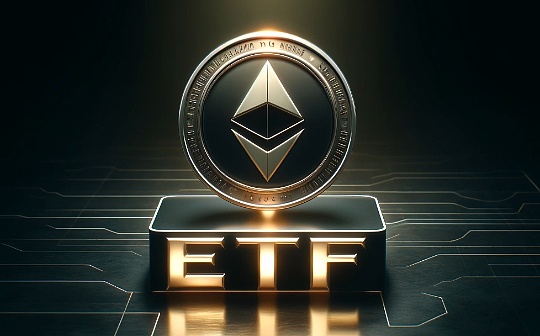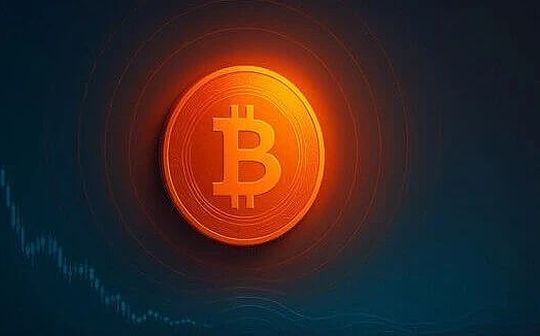
Author: GlassNode, Marcin Miłosierny; Compilation: Tao Zhu, Bitchain Vision Realm
summary:
-
Overview of monthly:In April, although the transaction volume was high at the beginning of the month and ETF flowed into large quantities, Bitcoin still faced consolidating pressure. The price was between $ 60,000 and $ 66,700, mainly due to the selling of short -term holders.At the same time, the Ethereum ecosystem has triggered a fierce debate on the change of pledge rules, highlighting people’s concerns about the future of its scalability platform and monetary assets.
-
Market momentum:At present, GlassNode’s comprehensive momentum index indicates that the market is cooling.Several key indicators have entered a stage of decline, indicating that demand is reduced and positive momentum.
-
Index focus:Miners ‘income momentum uses the proportion of miners’ cost income to evaluate the demand for block space, and the key inflection point is displayed through two years of scores.The high of Z scores indicates that the increase and congestion of the network activity, while the low of Z scores indicates that the demand is reduced and the potential market cools down.
In April 2024, investors in the digital asset market seemed to be affected by the two main emotions: the expectations of the fourth halved of Bitcoin and the disappointment of the sluggish price trend.Although the halving in history is proven to be a long -term bullish incident, they often cause market selling reactions in the short term.
For example, although the reduction of Bitcoin supply has a long -term bullish effect, similar incidents that occurred in 2016 and 2020 also caused the market to adjust immediately.This year, the macroeconomic uncertainty and geopolitical tensions have exacerbated this impact, resulting in 16.09%of Bitcoin prices fell within a few weeks after the decrease.
same,Ethereum also experienced significant fluctuations, and its price fell 17.80%, partly due to continuous uncertainty related to the US economy.Pay attention to the approval of Ethereum ETF and the debate of the community in the community.
This reaction reflects the wider market’s sensitivity to major expected events, and traders usually make a profit leading to short -term sales.In our extensive reports on halving and its expected impact, we properly expect such selling.
In this article, we will explore the continuous influence of the United States.Even in the case of the market, the spot ETF still significantly supports the transaction volume in April.We will also provide the latest factors that may affect Ethereum currency characteristics and its technical adaptability in the field of DEFI.
Monthly Market Overview
With the support of the surge in spot transactions and chains, in the first few weeks of April, Bitcoin continued its strong performance.Following the peak of about 14.1 billion US dollars in the spot transaction volume in mid -March, the price of Bitcoin was consolidated between $ 64,000 and $ 73,000.This price level is mainly driven by the American spot ETF. They have become an important force in the market. They have introduced a large number of new demand to help maintain the price level above the historical high.
Although the daily spot transaction volume decreases from the peak in mid-March to about 7 billion US dollars per day, it can still reach the strength of the bull market in 2020-2021.The strong transaction volume highlights the continuous optimism of the market. It is characterized by the accumulated transaction volume of Delta (CVD).The measuring net amount of buying and selling is highlighted, highlighting the continuous speculative interests and the widespread bullish mood in traders.
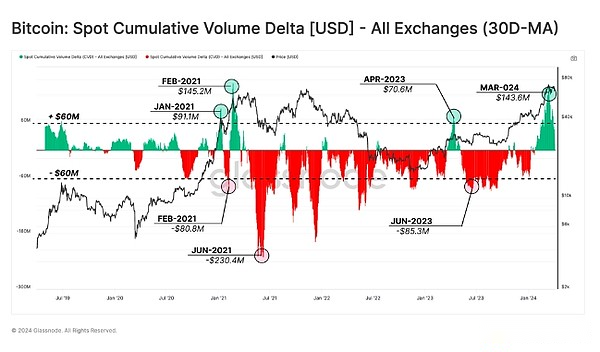
In addition, the transaction traffic (whether it flows or flows out) is very high, with an average of 8.19 billion US dollars per day, which greatly exceeds the peak level observed during the last bull market.Although Binance still occupies a considerable market share (37.5%) in spot transactions, its dominant position has decreased compared with the high level of previous years, which indicates that the market activities of various platforms are expanding.
The impact of halving
In mid -April, Bitcoin experienced the fourth halving incident, the daily supply inflation rate decreased by 50%, and the annual circulation rate fell to 0.85%.This reduces the hard currency status of Bitcoin, marking that Bitcoin surpasses gold for the first time in terms of distribution scarcity.
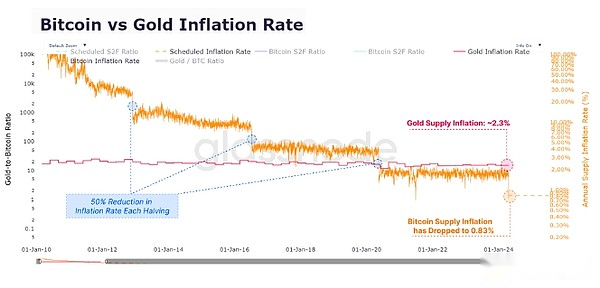
at the same time,The decrease in circulation has not had a significant impact on the market dynamics, because compared with global transaction volume, newly -mining tokens accounted for a small proportion.The trading volume of spot and derivatives continues to dominate the market, and the proportion of new supply accounts for total capital flow is less than 0.1%.
on the other hand,Bitcoin has reached a new milestone on several important indicators.The fundamentals of the network show a significant trend on various indicators.As miners invest in high -efficiency hardware and optimize operating costs, the network computing power has reached a record high, and ensuring that the reduction in circulation will not affect the safety budget.This investment shows that the reduction of subsidies is not an obstacle for miners.
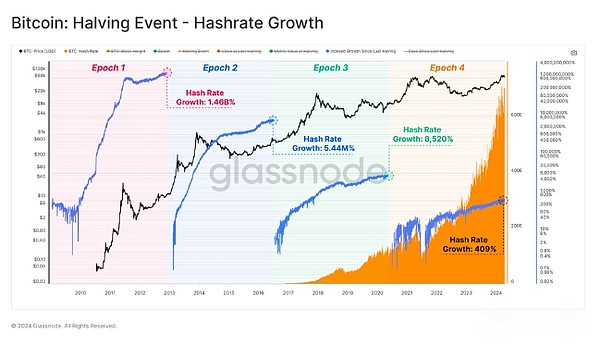
Despite the expansion of the ecosystem and the growth rate of network statistics, the absolute value of these indicators has reached a new high.In particular, in the past four years, the value of transfers and settlement through the Bitcoin network is as high as 106 trillion US dollars.This impressive number is prominentBitcoin has the ability to maintain its status as the main settlement network, regardless of volatility and periodic retreat.
Copy market adjustment
In the last week of April, the Bitcoin market entered the consolidation phase after the reduction of the incident.After the peak of $ 73,000 in March, the price range is between $ 60,000 and $ 66,700.During this period, the seller’s pressure intensified, because the short-term holder (STH), especially those who bought BTC in the past 1-6 months, led market losses.
Despite the increase in selling pressure, the NUPL indicator has not been achieved indicates that the market is still in the “excitement” stage of the bull market.However, since the beginning of adjustment, the indicator has also shown meaningful cooling.Skating pressure from STH, which has achieved major losses, has become a key indicator of the low point of the local market.
We can observe the cost basis of the cost of buying BTC STH in the past week to 1 month is the key indicator of market emotions.Their loss often reaches its peak near the bottom of the local market, which indicates thatThe fatigue of the seller in this group often indicates the upcoming reversal.
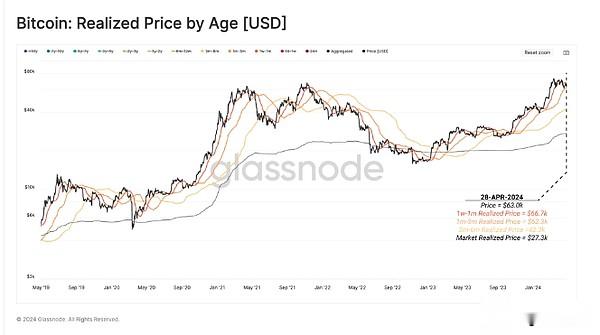
The development and dispute of Ethereum
In April, the Ethereum ecosystem found that he was in the center of the fierce debate around the network pledge policy.New innovations such as liquidity pledge, re -pledge, and liquidity re -pledge agreement have greatly increased the pledge demand on Ethereum, leading to an unprecedented growth of pledge participation.At present, more than 31.4 million ETH (about 26%of the total supply) has been pledged, which is mainly promoted by the re -pledged agreement such as EigenLayer and liquidity recreation providers.These development brings additional income opportunities, creating incentive measures that surpass the vision of the initial rights and interests.
The proposal to restrict annual circulation to slow down the expansion of the pledged pool has been strongly resisted by the community.Supporters believe that such measures are necessary for maintaining the role of Ethereum and preventing derivatives from getting too much influence on the Internet.However, opponents believe that these restrictions are obstacles to innovation and do not need to change.As the stakeholders strive to balance the needs of Ethereum’s monetary policy and decentralized finance, these debates will continue.
at the same time,People are still worried that the rapid growth of pledge may weaken Ethereum as the function of monetary assets and shift governance power to derivatives of pledged token.The future of the Ethereum pledge pattern is still uncertain, because the community needs to adopt this subtle balanced behavior to protect the scalability of the network and its function as a value storage.
Market motivation -update and key opinions on the chain momentum framework
During the bull market, the market momentum needs to analyze the data on the key chain in detail to capture the basic trends and changes of market behavior.The exploration framework of GlassNode provides potential methods to solve this dilemma by focusing on the four main categories:
-
Chain activity:This indicator uses network activities and adoption to determine the growth and expansion period of the user base.The increase in network activities is usually related to the rise in market motivation.
-
Market profitability:By evaluating the unrealized profits held by investors, this indicator can identify the period when market participants have obtained benefits, which can show that the market is healthy and rising.
-
Expenditure behavior:This category finds that there is enough need to absorb the period when the existing holders have made a profit.The high demand during these periods indicates a continuous positive momentum.
-
Fortune allocation:By checking the wealth transfer between long -term holders and new market participants, this indicator provides insights on market cycles and potential inflection points.
By integrating these indicators into the integrated index, analysts can better evaluate the strength and direction of market motivation.This method enables traders to make wise decisions based on a detailed understanding of the current state of the market and the potential trend of the future.
At present, less than 4 of the 8 conditions of strong kinetic energy are satisfied, indicating thatThe market is in the cooling periodEssence
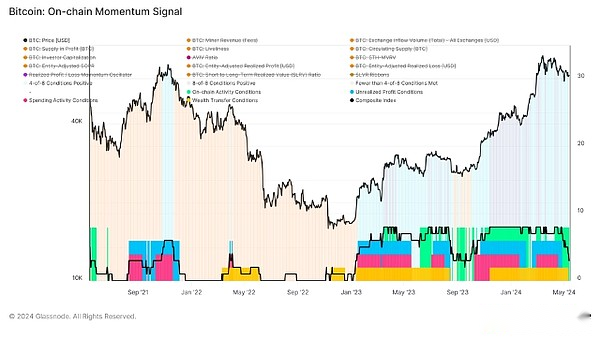
After the Bitcoin halved incident in April 2024, several key indicators have changed significantly compared with the previous trend, reflecting that the market dynamics may have a short -term change:
-
Miner’s income of 2 years Z score:After halving, the competition in block space intensified, especially in rune transactions, miners’ income soared significantly.Although this growth has slowed slightly, the level of income is still higher than the normal level of history.HoweverRecently, miners’ income has entered a stage of decline for the first time in the two -year Z score, indicating that the demand for block space has decreased.
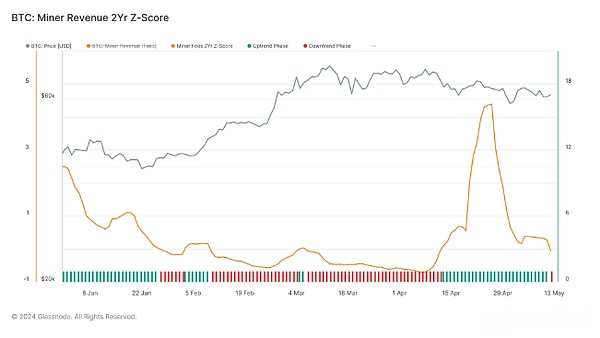
-
Exchange flow:The inflow of the exchange was originally maintained higher than the average annual level, reaching its peak in late March, and then entered a continuous decline.This change indicatesThe positive momentum of market capital inflows is slowing down and may soon reverse, indicating that the purchase pressure is cooling.
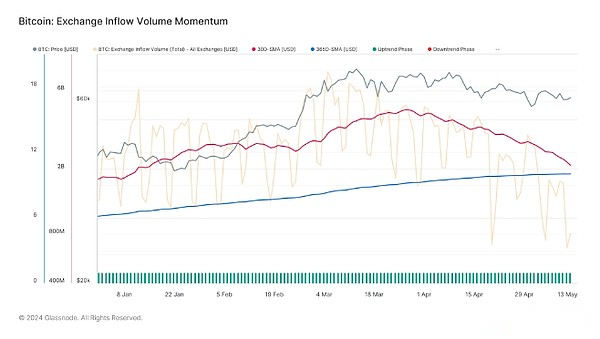
-
Profit supply trend:Although it still shows a positive trend, the profit supply has begun to show signs of reversal, whether the absolute value or the 90 -day EMA.Although this indicator is still in the stage of upward trend, it shows that there are fewer holders in a profit state, which may affect market emotions.
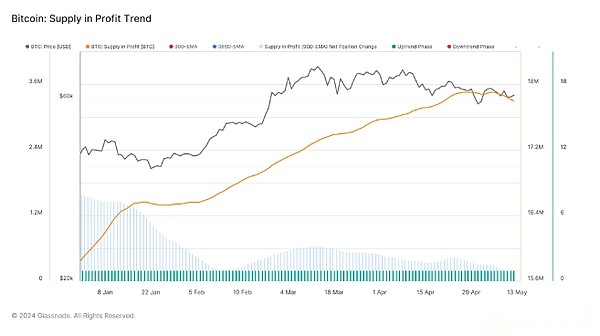
-
MVRV momentum:The overall market value and the value (MVRV) momentum are still higher than the average annual level, indicating that on average, the position valuation is still higher than its cost foundation.However, the short -term holder MVRV has reversed and is currently showing a downward trend, which indicates thatPeople who have recently entered the market have begun to see a decrease in profits, which may increase selling pressure.
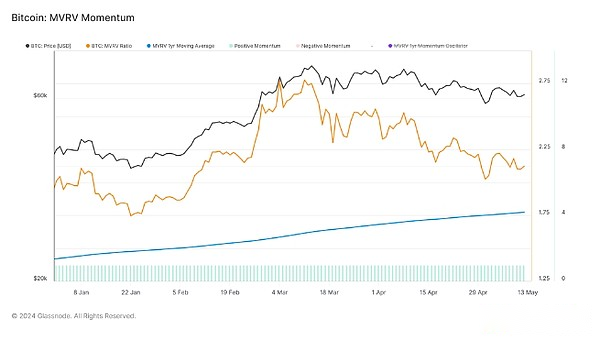
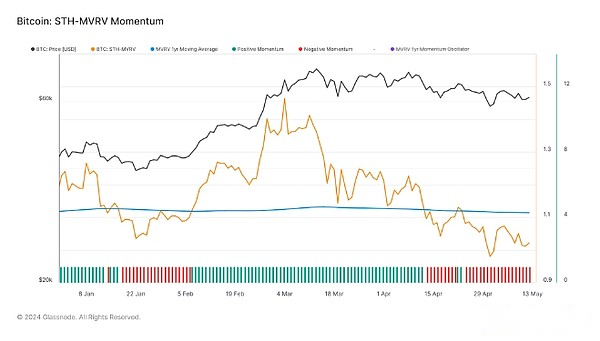
-
SOPR momentum:The momentum of expenditure output profit margins (SOPR) has also declined, and the average monthly average is recently lower than the annual average.This trend is not strong, butIt shows that the profitability of trading tokens is declining, which may lead to more cautious expenditure behavior of traders.
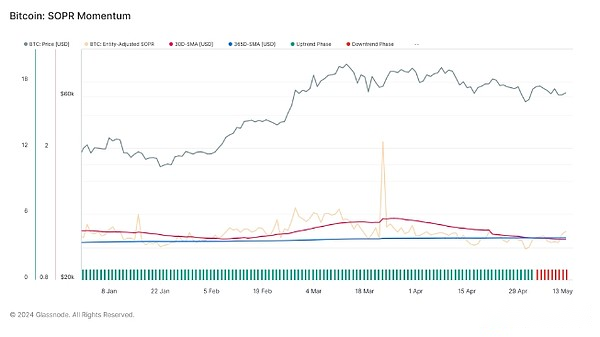
-
The amount of profit and loss has been achieved:The transformation of this indicator to negative volume highlights that the loss has accelerated during the recent market adjustment.If the market continues to be adjusted, the increase in the losses of token buyers in the near future may cause panic selling.
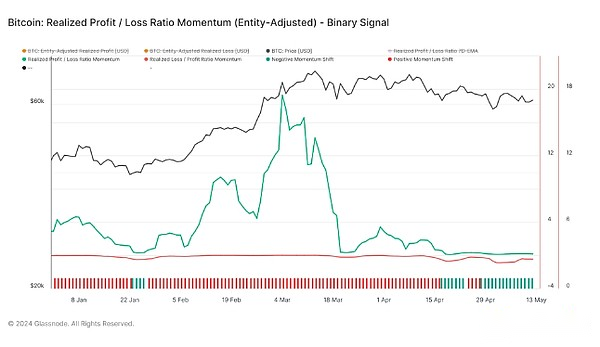
The conclusions and feasible opinions on the traders of the momentum
The current market indicator indicates,Bitcoin is undergoing a consolidation and potential correction stage.In view of the key indicators such as exchanges, SOPR momentum, and short -term holders MVRV, etc.The positive momentum slows down and the pressure of selling pressure has increased, and traders should keep cautious.The changes in the income of the miner and the cooling of the SOPR momentum further indicate thatThe demand for Bitcoin at a higher price level may be weakening.
For dynamic traders, closely monitoring these downward trends is crucial.If there are signs of recovery or stability, the possibility of reversal such as SOPR and profit supply may provide a strategic entry point.However, the increasing loss of losses prominently be vigilant about potential panic selling.
The focus of index attention -the momentum of the income growth of miners
In our analysis of market momentum trends, we emphasized the amount of motivation for miners.This indicator uses the income ratio earned by miners to measure the demand for block space.When the user shows higher urgency and is willing to pay higher costs to incorporate the next block, the cost pressure will increase.By scoring Z scores for 2 years of applications, we can standardize data sets and find inflection points across cyclicals, such as rising costs during the weakening of the bear market or a decrease in the cost of the cycle peak.
By checking the amount of miners ‘income, analysts can measure the intensity of network activities and their impact on miners’ behavior.High Z scores indicate that the income of miners is higher than the average level, which is usually at the same time as the increase in transaction costs and the increasing network congestion.Instead, the decrease in Z scores indicates that the demand for block space is reduced, which may indicate that the market is cooling or reduced trading activities.
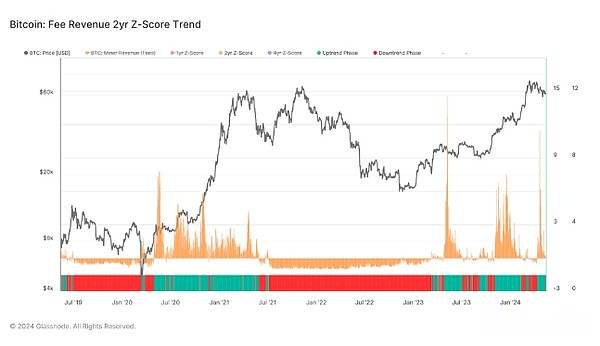
-
Find the trend:The increase in miners’ income is usually corresponding to the market stage of the bullish, because the high demand for block space usually reflects the increase in transaction activities and network utilization.On the contrary, the decline in income of miners may indicate weakened interests and potential market integration.
-
History case:A few days after the halves of April 2024, due to the fierce competition in block space, the momentum of the income of miners soared.Similar peak values were also observed in the previous reduction and major network events, which is a strong indicator for market activities.The current decline trend of Z score marks the change of the peak, indicating that speculation enthusiasm may be alleviated.
-
Change of indicators:Miners ‘cost income percentage, miners’ cost Z score functional zone income, miners surrendering risk.

